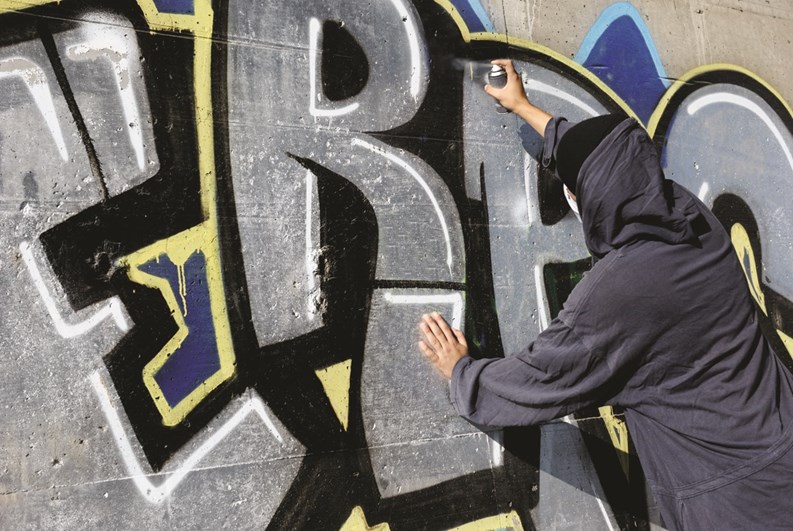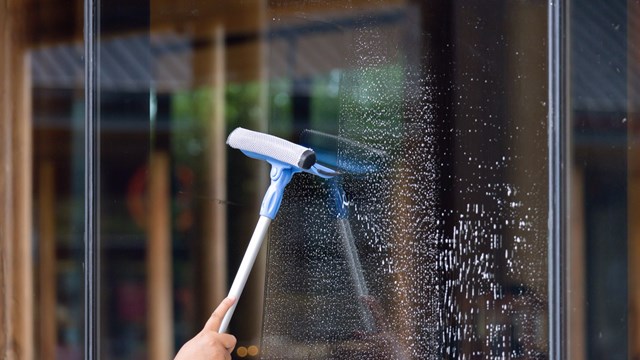While nowhere near as prevalent as it was in the 1980s (when it seemed as if one couldn’t find a clean wall in the city), graffiti has never completely disappeared from Chicago...or any metro area, for that matter. In fact, the city’s sanitation department gets between 80,000 and 100,000 graffiti complaints every year, and spends $5 million removing it.
The Oxford Dictionary defines graffiti as “writing or drawing scribbled, scratched, or sprayed illicitly on a wall or other surface in a public place.” Most of it is “tagging,” a name spray-painted on a wall, often put up in lightning speed.
Speed is the operative word.
Tim McCahill, owner and founder of McCahill Painting Company, which operates Chicagoland Graffiti Removal, recalls an instance of quick-draw tagging on the wall of a church. “The guy walked up, grabbed something out of his bag, tagged the building—with the security cameras on—and then kept walking. Very brazen, on film, and they knew it. Half a block down somebody picked him up in a car…and they’re gone.”
The vandal’s speed is why so few are arrested. “It’s a difficult crime to catch somebody in the act of doing because it happens so quickly,” Police Commander William Dunn told the Chicago Tribune. The city recently more than doubled the fine for graffiti vandalism, raising it to $1,500 to $2,500, and increased the maximum fine against parents of minors convicted of graffiti vandalism to $1,000. In 2013, however, just 3,000 people were charged with criminal defacement, and of those, only 350 were hit with charges.
Look at Me!
Whether put up by kids looking to attract attention (frequently the case), or by gangs to mark their territory, graffiti is a primarily an urban phenomenon. “The closer you get to Chicago, the worse it gets…although we’ve had the same problem in the northern suburbs,” notes Clint Coronado, president of Program One Professional Building Services, based in Des Plaines.
The ban on the sale of spray paint to minors in Chicago, instituted in 1992, encouraged some resolute taggers to shop outside of the city. “You’ve got a lot of kids going out to the suburbs to buy the paint,” says Mark Wiatr of High Definition Powerwashing, based in Palos Park. “Now you have them tagging in the suburbs, leaving a trail on their way back to the city.”
Taggers will go to outrageous lengths to throw up their tags…sometimes, dangle from rooftops. “A lot of the kids put their lives on the line,” says Waitr. “It’s dangerous enough for us, wearing harnesses in a man lift. But for them, dangling, it’s very dangerous.”
McCahill recalls working on a building that was directly across from a massive police station. “The tag was around five feet tall by 15-to-20 feet long and, probably, 20 feet in the air.” How did they get up there? “I can’t explain that,” says McCahill. “Taggers will do some very dangerous stuff so that it is visible.”
Removal from Historic Structures
According to a brief from the National Park Service’s division of the Technical Preservation Services, “Successful graffiti removal from historic masonry depends on achieving a balance between breaking the bond between the graffiti and the masonry surface without damaging the masonry. This generally requires knowledge both of the materials used to make the graffiti and the masonry on which the graffiti has been executed, as well as knowledge of cleaning methods and materials. Without this, masonry surfaces can be badly disfigured or damaged during graffiti removal.
“The word graffito (graffiti, plural)—is derived from the old Italian diminutive of graffio-to scratch, and the Latin graphire-to write.” Graffiti in contemporary usage has come to mean an inscription, drawings, or markings. Except in very formal or technical applications, graffiti is generally considered a "mass" noun and paired with a singular verb.
Spray-Painted
The brief notes that most graffiti is made with spray paints. Although a number of solvents and paint strippers are capable of dissolving or breaking down these paints, some may permanently discolor or stain the masonry surface if not used correctly. As a result, the remaining paint may become more difficult, or even impossible, to remove. Poorly thought-out and generally hasty attempts to remove graffiti using harsh chemicals or abrasives can also cause permanent damage to the masonry that may be worse than the graffiti.
“The ability to identify the graffiti material is an important step in successful removal. Numerous kinds of spray paint (polyurethanes, lacquers, and enamels), and brush-applied paints (oils and synthetic resins such as vinyls, acrylics, acetates, methacrylates, or alkyds), as well as permanent felt markers are the materials most often used to make graffiti. But other materials are also used for graffiti, including water-soluble felt markers, ballpoint pens, chalk, graphite and colored pencils, pastels, wax and oil crayons, liquid shoe polish, and lipstick. The range of materials adopted by graffitists continues to expand.”
Paints are composed of pigments that provide color and hiding power; binder that holds the pigments together and to the substrate; and a solvent that allows the pigment/binder mixture to flow. Some spray paints and markers may contain dyes instead of pigments. Paints are applied wet. Generally, as the solvent evaporates, the binder solidifies. The greater the solvent content of the paint, the greater the flow rate, and thus, the greater the ability of the paint to penetrate into masonry pores.
The two primary components contained in most graffiti materials—pigment or dye, and binder—may simply remain on the masonry surface, or penetrate into the masonry to varying depths depending on a number of factors, including the surface tension of the substrate and viscosity of the solvent or vehicle. “Thus, even the total removal of the pigment or the binder may leave residues of the other component actually in, or below, the surface of the stone. Residual stains, or graffiti "ghosts," such as those from any kind of red paint or the fine black pigments used in spray paints, may be particularly difficult to remove.”
Out Now, Damned Spot
The City of Chicago offers one of the nation’s most effective public graffiti removal programs. Its team of graffiti-blaster trucks responds to almost all of the complaints registered with the Department of Streets and Sanitation within about seven days.
That, however, might be six-and-a-half days longer than a condo or HOA wants to tolerate. Once your building is hit by graffiti, experts recommend taking it down immediately. Left up overnight, graffiti begets graffiti.
“More than likely, if somebody puts a tag on, history tells us that if it goes untreated, they will come back and put it on again,” reports Ed Talmo of Enviro-Northeast Sales Corporation in Highland Lakes, New Jersey, a distributor of anti-graffiti products.
“The whole key to having a successful graffiti-free building,” he advises, “is to tune in every morning, and if you find graffiti on your structure, remove it immediately so that kids don't get a chance to see it.”
Additionally, stick with the program, even if the vandals return a few times. “That can go on for a while,” says Talmo. “It becomes a battle of wills. But if they don't get to see it, they will soon move on to other structures that are not maintained so well.”
Coronado recalls one such battle of wills. “For, probably, a good seven to 10 days we battled with this guy; he put up a little tiny tag…could not have been bigger than one-foot by one-foot. We painted over it, and he came back and did it bigger; painted over that, and he came back and did it bigger. By the end of the week, he was trying to take up the entire 20-foot long wall with his little tag.” It took a police detail sitting at the site for several nights to banish the vandal.
In practical terms, the most important reason to act fast is that, advises McCahill. “The more it penetrates into the substrate, the more difficult the removal process is, and the greater the chance of shadowing [leaving a trace]. A lot of times we will take off all the paint, but you can still see where it was.”
Building staff can take a stab at removing graffiti themselves, but most are ill-equipped. Most tags will require a pressure washer, which is an expensive piece of equipment and requires precision operation. Used improperly, high-pressure washers can damage a masonry façade.
The Tagger’s Toolkit
Graffiti writers use paint almost exclusively, dispensed from aerosol spray cans, which offers speed and portability. If you’re lucky, the tagger used a water-based acrylic, which is washed off easily. But most use oil-based paints, which are more difficult to remove. Some use epoxy-based paint, which is near impossible to get out completely and often leaves shadowing.
The easiest and cheapest solution is to paint over the graffiti, and it might be tempting to slap paint on the back or sides of the building, which are not visible to the public. Talmo advises against it. For one thing, he says, “non-breathable coatings trap the moisture. Over a few years you have freeze-thaw cycles. The moisture in there can't get out, and starts breaking down the capillaries in the mortar.”
Also, a freshly painted wall welcomes the taggers back. “It's like giving them a brand new canvas,” says Talmo.
Graffiti Removal
The graffiti removal process is a variation on two themes: loosening the paint and blasting it off with pressurized water, sand, or baking soda.
There are a wide range of chemicals specially designed to attack graffiti on the market, most with colorful, catchy names, like Elephant Snot, Taginator, Sludgehammer and those made by World’s Best Graffiti Products, available in a variety of formulations to treat different types of surfaces, including sensitive, historic stone and brickwork and masonry.
“It’s trial and error,” says Coronado. “You bring out six different cleaning products, including paint thinners, and you try each one of them to find the right one. Depending on the material of the building, one product that could work great at removing paint from a certain surface could damage another surface. You can’t go splashing stuff all over the place and expect it to work. You've got to do a little test area and make sure it removes the graffiti and it doesn't damage anything.”
Most of the popular products are biodegradable. A few are said to be made with natural ingredients exclusively, such as citrus juices. Though, there are no official green standards; they are self-certified. “There is a lot of snake oil within the industry,” Talmo claims. “Manufacturers telling people that their products were breathable and they really were not. There is no standard.”
He likes the old standbys. “Some of the harsh older chemicals seem to work the best. If you have both potassium hydroxide and methylene chloride paint strippers on a vehicle, and you go to remove graffiti, you can get off most pigments.”
If you put up a protective coat after removing the graffiti, he insists, “there's nothing more green and environmentally safe then using these heavy-duty chemicals one last time to clean it. Put the barrier up and go back to a biodegradable cleaner for years and years and years.”
Blast Off
Spraying the loosened paint off is the next step. The most common method is power-washing the wall with a 3000 PSI-pressure washer spraying 250-degree water, using the appropriate nozzle tip for the job. Too narrow of a spray can etch the masonry surface.
Applied after allowing the chemical solvent to settle into the surface, power-washing will completely remove the graffiti in most cases. Some surfaces, like stone or soft brick, will require sand-blasting or soda-blasting, a newer alternative to sand-blasting that uses baking soda.
“On historical surfaces,” says McCahill, “we start with the gentlest process possible and go up from there. Some tags can take two or three visits to get completely out. But 95% of the tags we get off right away.”
Anti-Graffiti Coatings
If your building is hit more than once, you should consider putting on a paint-resistant coating, which prevents graffiti from bonding to surfaces. There are two types of anti-graffiti coatings. The sacrificial coating lays an easily-removed clear barrier over the surface. If the wall is tagged the coating can be removed using a high-pressure washer, taking the graffiti with it. The coating, which is an inexpensive clear polymer, must then be reapplied to repel repeated tagging.
Permanent coatings —which create a protective surface which paint cannot bond to—are more expensive, but only have to be applied once. Often made from polyurethane or fluorinated hydrocarbon (which is particularly effective in repelling spray paint), permanent coatings can be washed free of paint with a simple solvent and a hose or low-pressure power-washer. Coating the façade is expensive, but one multilayer coat can withstand 15-20 graffiti removals.
Fortunately, graffiti rarely appears on the inside of buildings, which is protected by locks, staff, and cameras. If it does, there is no need for heavy equipment. Metal surfaces—which do not absorb paint—can be wiped down with a common paint thinner and rubbed with steel wool or sandpaper. Wood can be wiped down with mineral spirits. The best way to remove painted graffiti from glass is to scrape it off with a razor blade or apply paint thinner.
If your building is hit by the infamous Banksy on his next flash tour of New York City, mount a thick sheet of protective plexiglass on the work and call Sotheby’s. If the graffiti writer is of any less renown (which includes everyone else), remove it immediately and put up a protective barrier and, rest assured, your building will be the last in the neighborhood to be hit again.
Steve Cutler is a freelance writer and a frequent contributor to The Chicagoland Cooperator.







Leave a Comment